调控网络:将难辨梭状芽孢杆菌的毒素生产和孢子繁殖联系起来。
IF 2.6
3区 生物学
Q3 MICROBIOLOGY
引用次数: 0
摘要
艰难梭菌已被公认为一种重要的院内病原体,它因接触抗生素而导致腹泻,每年给医疗系统造成数十亿美元的损失。艰难梭菌以休眠孢子的形式进入宿主肠道,发芽成为无性细胞,在肠道内定植,并产生毒素 TcdA 和/或 TcdB,导致腹泻和炎症。孢子是主要的传播媒介,而毒素 A 和毒素 B 则直接导致疾病。因此,产生毒素和孢子是决定艰难梭菌能否成为病原体的关键特征。在静止后期,毒素和孢子都会在各种刺激下产生。本综述全面分析了有关分子机制的现有知识,重点介绍了艰难梭菌毒素基因表达和孢子产生之间的调控途径。文中讨论了碳水化合物、氨基酸和其他营养物质及信号在通过全球调控网络调节这些毒力特征方面的作用。了解基因调控网络内部的联系对于开发针对艰难梭菌感染的有效治疗策略至关重要,有可能导致有针对性的干预措施,破坏毒素生产和孢子生成的共同调控。本文章由计算机程序翻译,如有差异,请以英文原文为准。
Regulatory networks: Linking toxin production and sporulation in Clostridioides difficile
Clostridioides difficile has been recognized as an important nosocomial pathogen that causes diarrheal disease as a consequence of antibiotic exposure and costs the healthcare system billions of dollars every year. C. difficile enters the host gut as dormant spores, germinates into vegetative cells, colonizes the gut, and produces toxins TcdA and/or TcdB, leading to diarrhea and inflammation. Spores are the primary transmission vehicle, while the toxins A and B directly contribute to the disease. Thus, toxin production and sporulation are the key traits that determine the success of C. difficile as a pathogen. Both toxins and spores are produced during the late stationary phase in response to various stimuli. This review provides a comprehensive analysis of the current knowledge on the molecular mechanisms, highlighting the regulatory pathways that interconnect toxin gene expression and sporulation in C. difficile. The roles of carbohydrates, amino acids and other nutrients and signals, in modulating these virulence traits through global regulatory networks are discussed. Understanding the links within the gene regulatory network is crucial for developing effective therapeutic strategies against C. difficile infections, potentially leading to targeted interventions that disrupt the co-regulation of toxin production and sporulation.
求助全文
通过发布文献求助,成功后即可免费获取论文全文。
去求助
来源期刊

Anaerobe
生物-微生物学
CiteScore
5.20
自引率
8.70%
发文量
137
审稿时长
76 days
期刊介绍:
Anaerobe is essential reading for those who wish to remain at the forefront of discoveries relating to life processes of strictly anaerobes. The journal is multi-disciplinary, and provides a unique forum for those investigating anaerobic organisms that cause infections in humans and animals, as well as anaerobes that play roles in microbiomes or environmental processes.
Anaerobe publishes reviews, mini reviews, original research articles, notes and case reports. Relevant topics fall into the broad categories of anaerobes in human and animal diseases, anaerobes in the microbiome, anaerobes in the environment, diagnosis of anaerobes in clinical microbiology laboratories, molecular biology, genetics, pathogenesis, toxins and antibiotic susceptibility of anaerobic bacteria.
 求助内容:
求助内容: 应助结果提醒方式:
应助结果提醒方式:


